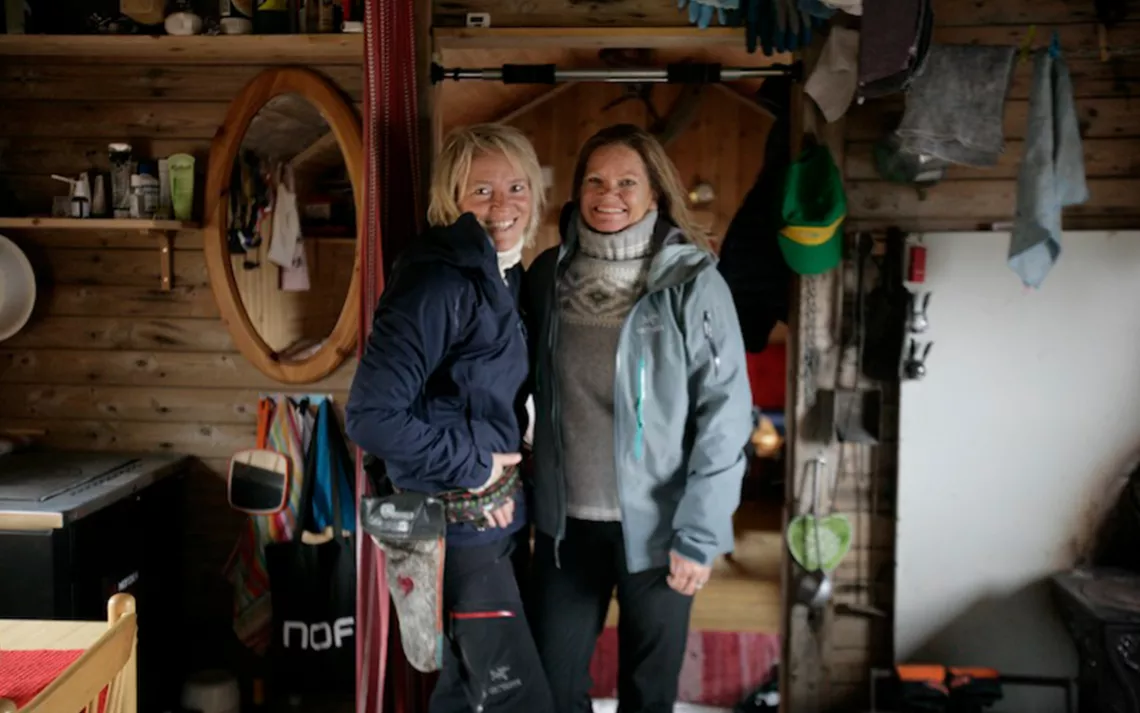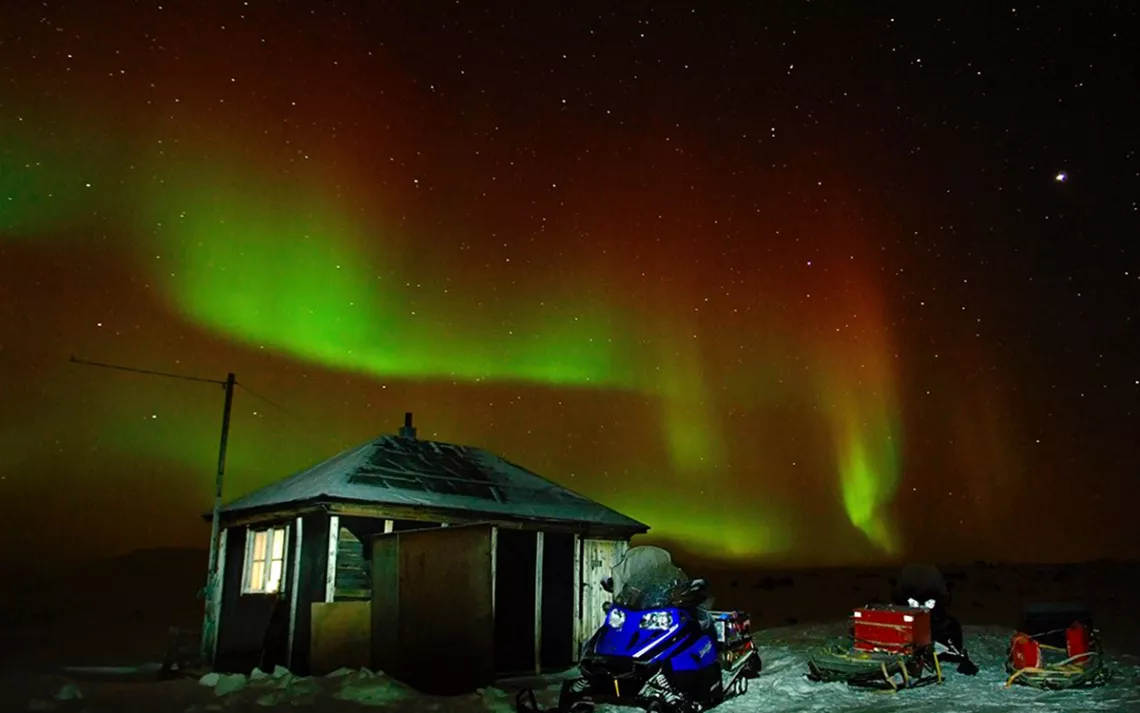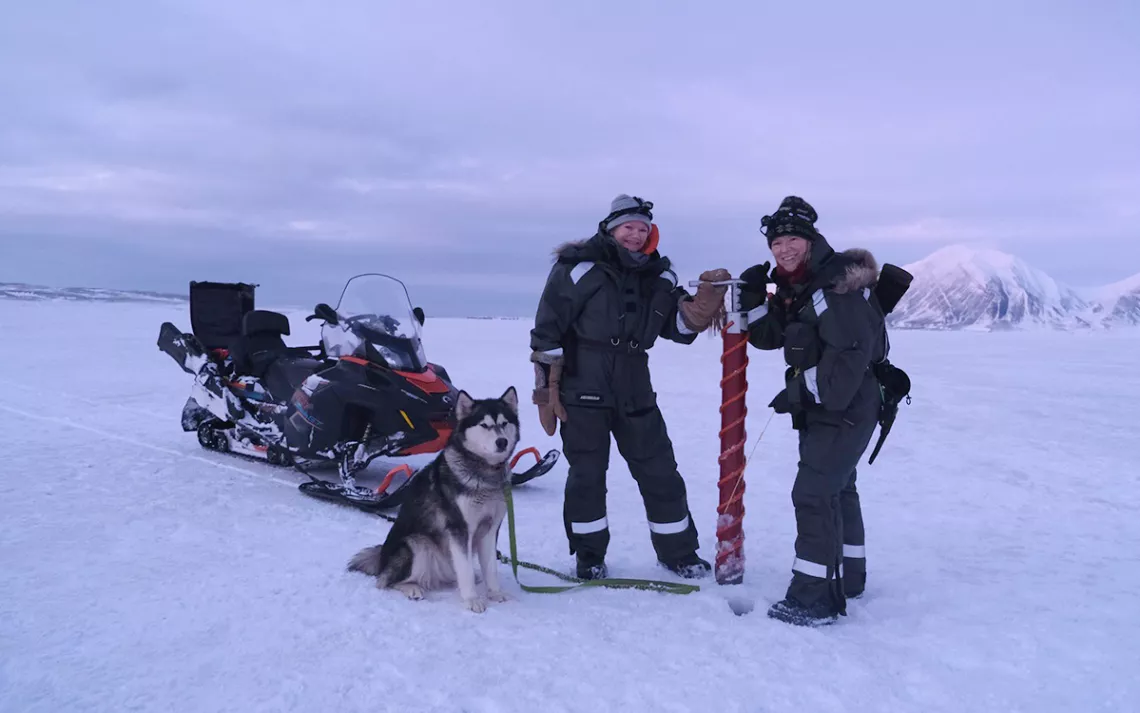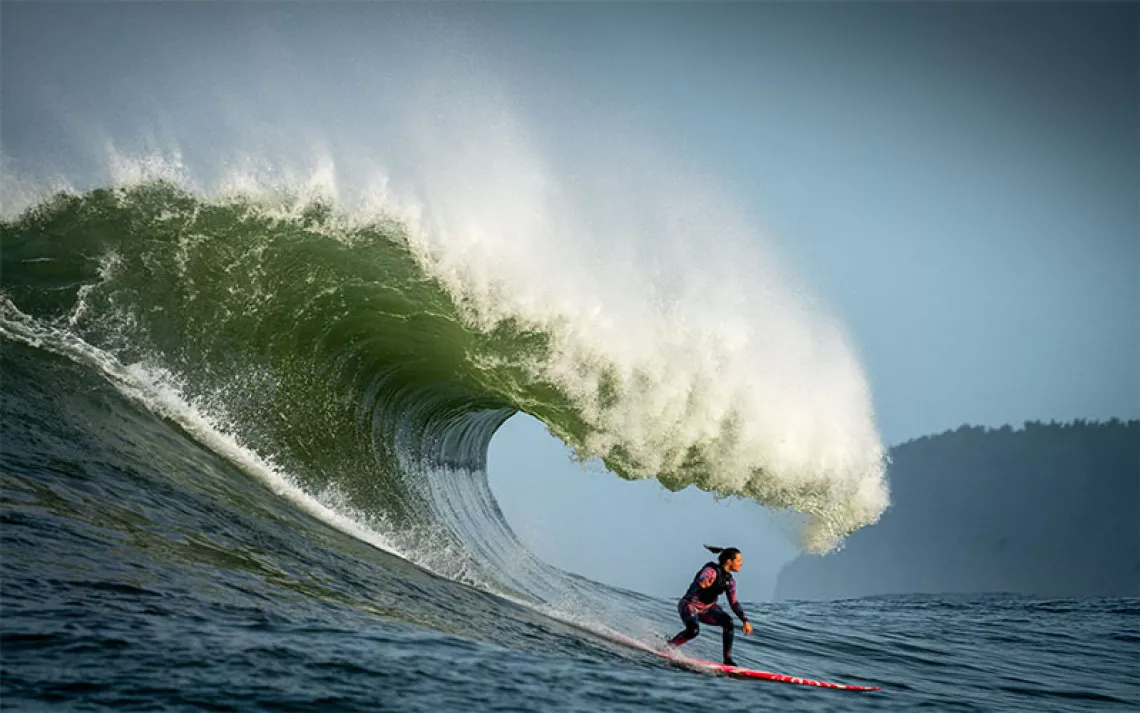The Women Who Logged 18 Months in the Arctic
Hilde Fålun Strøm and Sunniva Sorby did it for science

Photos courtesy of Hearts in the Ice
From a distance, the people trudging up a snow-blanketed mountainside into the silver peaks surrounding Leith Cove in Antarctica appear like a trail of bright red ants. The explorers’ brightly hued winter jackets pop against the iron-gray skies of the world’s southernmost and most mysterious continent.
Atop the mountain, hordes of chinstrap penguins make their nests. The birds waddle around like little old men, their wings akimbo as they squawk furiously at the petrels that circle above, vigilant for any opportunity to steal an egg or snatch a delicious baby chick.
Back along the flag-marked mountain path, Hilde Fålun Strøm and Sunniva Sorby, both in their sixties, lead struggling hikers through the snow. As “godmothers” of the Hurtigruten Antarctica expedition ship that brought in these explorers, the ladies are as comfortable in the harsh, unforgiving landscape of the Antarctic as anyone can be. Between the two of them, Strøm and Sorby have more than 49 years’ experience in polar and Arctic conditions—and recently, they’ve even made history in the Arctic.
In 2019, the women stayed together in a rustic trapper’s cabin in the High Arctic of Svalbard, Norway. From August 2019 to May 2020, Strøm and Sorby lived in the 65-square-foot cabin, called Bamsebu, braving Svalbard’s extreme Arctic winter to act as citizen scientists collecting data on climate change in the Arctic. In doing so, they became the first women in history to overwinter in Svalbard without men.
Now, the ladies aim to make history again—or more to the point, to change its course. Taking what they learned about how climate change is affecting the world’s most delicate ecosystems, Strøm and Sorby are promoting dialogue about it through the educational outreach platform they launched, Hearts in the Ice. The idea is to engage young people by connecting students from around the world with experts to promote dialogue around climate change’s impacts in polar regions, how these changes impact the rest of the world, and what everyday people can do about it.
Making history in extreme conditions
Both women had unwittingly spent a near-lifetime preparing to overwinter in Svalbard. Sunniva Sorby, a native of Squamish, British Columbia, Canada, was among four women to spend 1992 through 1999 skiing across the continent of Antarctica, from ice shelf to ice shelf, as part of the historic Women’s South Pole Expedition. Sorby was also the first Canadian woman to serve as expedition leader for the Greenland Crossing in 1999, and for the King George Island Crossing in 1998. She has skied the 195-mile Sierra Haute Route in the Sierra Nevada and climbed Africa’s Mount Kilimanjaro no fewer than five times.
Hilde Fålun Strøm, a native of Norway’s Svalbard Archipelago, spent more than 25 years traveling the archipelago, serving as an expedition leader for several challenges, and along the way encountering more than 300 polar bears. All told, Strøm has spent more than two full years total in trapper’s huts in the High Arctic.

Sign up to receive Sierra News & Views
Get articles like this one sent directly to your inbox weekly.
With this action you affirm you want to receive Sierra Club communications and may vote on policy designated by the Sierra Club Board.
Being so immersed in the Arctic led Strøm to gain a first-hand understanding of the devastating effects of climate change. By the early 2000s, she says she could already tell Svalbard was greener, and experiencing warmer temperatures and less sea ice. She was deeply impacted by the events of December 19, 2015, when a killer avalanche roared through her hometown of Longyearbyen, destroying 11 of her neighbors’ homes and killing two, including a two-year-old child.
The two women met in 2016, at the annual Adventure Travel World Summit in Alaska in 2016, and experienced an instant connection. They also immediately noticed that they wore identical rings, made by the same Inuit man from Sisimiut, Greenland. The two became fast friends, bonding over their love of Arctic and polar regions. During a visit to Sorby’s stomping grounds in Squamish soon thereafter, the seed of the idea to become the first women to overwinter in the unforgiving Arctic was planted.
Fast-forward to 2019, when Strøm and Sorby, accompanied by a three-year-old Malamute named Ettra, headed into the harsh Polar night to take up residence in Bamsebu (pictured, below), a tiny cabin with no insulation, running water, or electricity. This was no indulgent “make history” challenge—during those dark and isolated months, the women lived as lightly as possible, using an electric snowmobile and minimal supplies to collect data—on topics including microplastics, phytoplankton numbers, sea ice, water quality, animals, and, Strøm says, "everything observable in the Arctic world"—for researchers at various institutions including the Scripps Institution of Oceanography, NASA, the Norwegian Polar Institute, the University Center in Svalbard, and the British Columbia Institute of Technology.

When the global COVID-19 pandemic struck in early 2020, the women’s nine-month overwintering stay at Bamsebu turned into 18 months in the Arctic. All throughout those “bonus” months of isolation—which included near-daily encounters with 1,300-pound polar bears—Strøm and Sorby never stopped collecting data.
"Climate change is happening twice as fast up here in the Arctic," Strøm told Sierra. "So, we are sort of climate witnesses.”
Hearts in the Ice
Beyond serving as “citizen scientists,” they also discovered a mission to inspire people around the globe to become citizen scientists in their own right. “Following decades of polar exploration, we have watched the fragile Arctic change before our eyes, like ‘Hearts in the Ice,’” says Strøm. “We are compelled to spread awareness of the climate emergency and thus want to work alongside the heroes fighting to protect our planet.” So in 2017, the two women created their global nonprofit to promote conversation around issues relating to adventure, female leadership, STEM, sustainability, innovation, exploration, diversity, climate action, and alternative energy. Hearts In the Ice has connected scientists, educators, business leaders, and experts (including famed primatologist Jane Goodall) with more than 100,000 children worldwide.
Via satellite video chats from Bamsebu, Strøm, and Sorby spoke candidly with hundreds of thousands of schoolchildren about what they were witnessing in Svalbard. Through a Hearts in the Ice program called “Exploring by the Seat of Your Pants” that highlights the work of field experts, they continue to engage classrooms around the world.
“Climate change is huge, and it's paralyzing and it's causing mental illness and despair in kids today, and this is not a joke,” Sorby says. “It's important for all of us to find nondivisive ways, nonconfrontational ways to engage in conversation with those who disagree with what we believe in and try to find a way to connect with people from human to human standpoint.”
Nowadays, Strøm and Sorby promote citizen science projects like NASA’s GLOBE Observer and Aurorasaurus and lead citizen science education on cruise ships such as the one on which I met them, on Hurtigruten Expeditions Antarctica.
“It may seem like a lot of fun, and it’s designed to be fun,” says Sorby of cruise ship citizen science, “but the impact of this is collecting valuable data to study what's happening and the changes that we're experiencing.”
Last year, Sorby and Strøm published a book, Hearts in the Ice: The Adventures of the First Two Women to Overwinter in the High Arctic of Svalbard, in which they reflect on their unique roles in the world. “Though we never thought of ourselves as activists, we now see we are in our role as citizen scientists. Our role as bridge builders between researchers and citizens is one drop in the bucket—but a necessary one.”

 The Magazine of The Sierra Club
The Magazine of The Sierra Club



